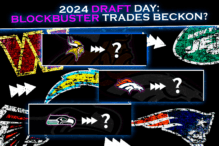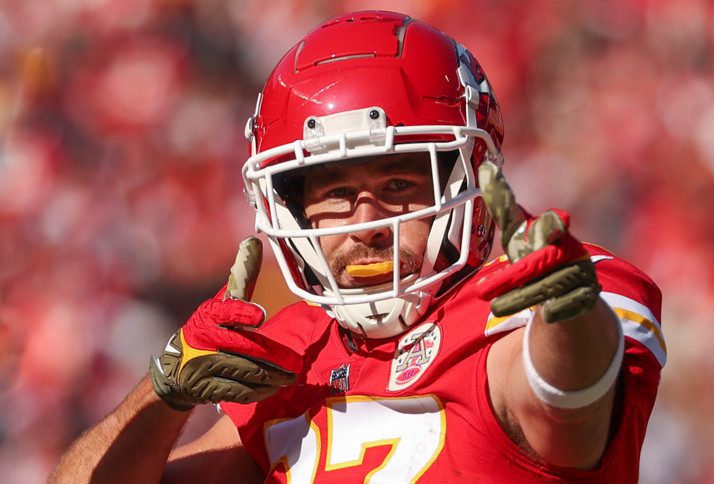

Today marks the start of mandatory minicamp for 10 teams – and with training camp fast approaching, Decyfr presents an overview of each stage of the offseason following the draft, to ensure you’re clued in on all things NFL leading up to the 2024 regular season.
MARK YOUR CALENDARS 🗓️
Here’s what’s in store ahead of the 2024 Regular Season.#Decyfr #NFL #NFLUK pic.twitter.com/7j3udK0c6E
— Decyfr Sport (@DecyfrSport) May 3, 2024
Rookie Minicamp
Rookie minicamp is an opportunity for newly-drafted players and undrafted free agents to showcase their skills and build rapport with coaches and teammates. The minicamp, which is only for rookies, usually takes place in the first or second week after the NFL Draft.
It is an essential step in every team’s offseason program, as rookies commonly need extra time to process the complexities of an NFL playbook and the heightened expectations at the professional level – whilst also using the camp as an opportunity to settle into their new team ahead of OTAs.
OTAs (Organised Team Activities)
Organised Team Activities (OTAs) – which take place every few days from May 20th until early June – are split into three different sections. ‘Phase One’ for meetings, strength and conditioning and physical rehabilitation, ‘Phase Two’ for individual and group drills, and ‘Phase Three’ for organised team practices. All phases are voluntary, with players practising without pads.
OTAs are designed to provide a structured environment where players can apply that which they have learnt from team meetings – which take place from April 15th onwards. Coaches emphasise teaching and learning – with a focus on playbook installation, communication, and situational football. Position groups work closely with their coaches to refine individual skills, develop techniques and understand their particular role within the offensive or defensive scheme.
Veteran players often take on leadership roles during OTAs – mentoring younger teammates whilst facilitating an atmosphere conducive to collaboration. Participation in OTAs is a strong indicator of a player’s commitment and dedication to the team’s success – with the work forming the foundation for mandatory minicamp and subsequently training camp.
Mandatory Minicamp
Usually held in the first or second week of June, all players are obligated to attend mandatory minicamp – as the name suggests. The minicamp marks the culmination of the spring workout period – providing coaches with a comprehensive look at the roster and an early opportunity to fine-tune their strategies. If a player doesn’t attend the camp, teams are well within their rights to fine players for missing sessions.
Mandatory minicamp is an intensive period where coaches assess players’ progress and readiness for the upcoming season. Practices are more structured and demanding compared to those in OTAs. With an emphasis on executing plays at a high level, coaches are able to accurately evaluate players’ physical conditioning, mental grasp of the playbook, and overall performance.
This phase also serves as a checkpoint for team chemistry and cohesion. Coaches and front office staff make preliminary evaluations of the roster, identifying areas that need improvement before training camp.
ICYMI: The NFL’s annual Hall of Fame Game will take place on August 1st, with the @ChicagoBears taking on the @HoustonTexans in Canton, Ohio – kicking off the 2024 preseason.#Decyfr #NFL #HallofFame pic.twitter.com/zsuvt8sPLk
— Decyfr Sport (@DecyfrSport) March 26, 2024
Training Camp and Preseason Games
Undoubtedly the most intense period of every NFL offseason for players and coaches alike, training camp begins in late July and lasts until the end of August. Players practice in full pads – with teams looking to finalise their rosters through gruelling workouts and preseason games. Coaches evaluate a players’ performance, mental makeup and scheme fit in order to determine the final 53-man roster.
The demanding practices are aimed at improving fitness, team discipline, and tactical proficiency. Position battles are closely watched – providing an ideal opportunity for coaches to assess every players’ ability to perform under pressure and execute the playbook in game-like situations.
Starting at the beginning of August, preseason games give those players competing for roster spots a chance to demonstrate their ability against “live bullets”. Coaches will commonly use these games to experiment with play-calling and gameday strategies whilst simultaneously helping them to make informed decisions about the final roster. Teams aim to strike a balance between evaluating talent and minimising injuries – consequently, it is rare for starters to see substantial playing time during the preseason, if they suit up at all.
The intensity of training camps over the years is well documented – with Hall of Fame head coach Don Shula quickly forming a reputation for brutal sessions with minimal rest. In fact, in 2013, Bleacher Report highlighted that during Shula’s tenure “days off during training camp simply didn’t exist; Shula would work players seven days a week until camp concluded.”
In 2021, the NFL voted to extend the regular season to 17 games, thereby reducing the preseason from four games to three. As a result, joint practices became increasingly popular around the league. In the week leading up to their scheduled preseason game, both teams will usually spend two days training against each other. With starters, sparsely seeing the field in preseason games, joint practices provide a unique opportunity for each team’s stars to see the field against another team. Therefore, these sessions are invaluable to coaches when making final adjustments ahead of the regular season and final cuts.
Final Cuts, Waiver Wire and Practice Squad
Before the regular season, teams must reduce their 90-man rosters down to just 53. Once the final preseason game is finished, teams announce their final rosters on August 29th.
Despite around 40 players being cut, players with under four years of NFL experience qualify for waivers. When a player gets waived, their contract has not yet been terminated. First, they are placed on the waiver wire – allowing other teams to claim them within 24 hours.
Players with four or more years of experience, however, do not qualify for waivers and are known as ‘vested veterans‘. Therefore, when veteran players are cut, they immediately begin negotiations with other teams.
Alongside their 53-man roster, every team heads into the regular season with a practice squad. Traditionally, a practice squad consists of 16 players – a maximum of six veterans and 10 rookies – who provide the starting lineup with opposition during in-season practices.
A rule change ahead of the 2024 season now allows all 32 teams to roster a 17th practice squad player. However, according to NFL Football Operations, the additional spot is reserved exclusively for an international player, from outside the United States and Canada.
With the success of the International Player Pathway (IPP) program’s class of 2024 – headlined by former Welsh rugby star Louis Rees-Zammit signing with the Kansas City Chiefs – the likelihood of elite athletes from around the world utilising this new roster spot and taking their talents to the NFL, is greater than ever.
https://decyfrsport.com/all-you-need-to-know-nfl-offseason/
Copied!




















































































































